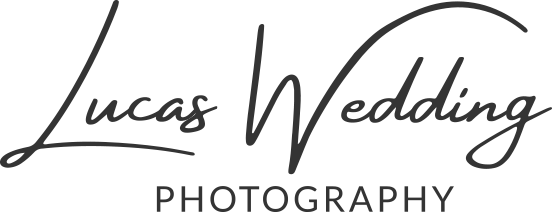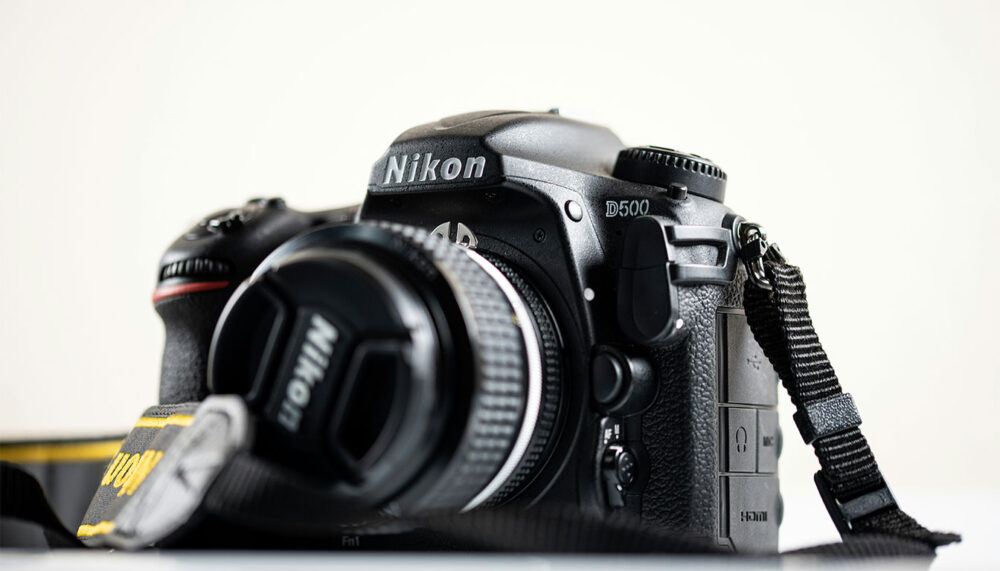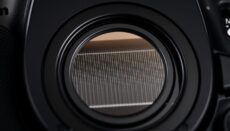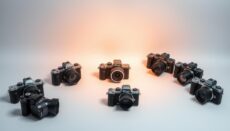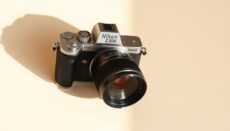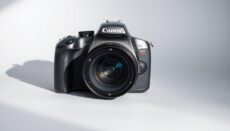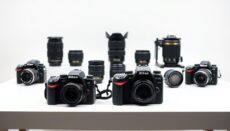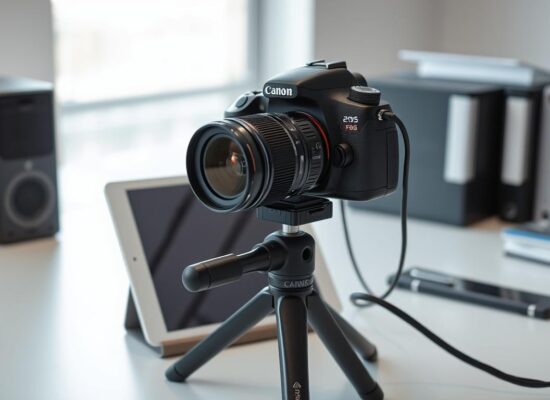Released in 2009, the Nikon D5000 quickly gained popularity for its blend of features and affordability. Even now, many photographers wonder whether this DSLR holds up against modern alternatives. With a 12.3MP CMOS sensor and EXPEED processor, it delivers decent image quality for casual shooters.
The articulating 2.7″ LCD screen offers flexibility, especially for live view shooting. Weighing just 588g, its lightweight design remains appealing for travel. Though outdated compared to mirrorless models, the D5000 still suits beginners seeking an entry-level DSLR.
Key Takeaways
- Launched in 2009, the Nikon D5000 remains a budget-friendly DSLR option.
- Features a 12.3MP sensor and 11-point autofocus system.
- Flip-out LCD screen enhances shooting angles.
- Lightweight body makes it ideal for travel photography.
- Compatible with AF-S lenses for versatile use.
Introduction
The D5000 made waves upon release, blending affordability with Nikon’s first articulating LCD screen. Its 12.3MP sensor delivered crisp shots, while 19 scene modes simplified photography for novices.
Today, the model appeals to hobbyists and budget shooters. Strengths like colour accuracy and dynamic range keep it relevant, though 4K video and modern connectivity are absent.
Upcoming sections explore its design, performance, and how it stacks against newer alternatives. For beginners, the D5000 remains a solid entry-level camera.
Design and Build Quality
Despite its age, the D5000 retains appeal thanks to a portable form factor and user-friendly layout. Its polycarbonate shell offers decent durability for casual use, though it lacks weather sealing. Weighing under 600g, the camera fits comfortably in small bags alongside its 18-55mm kit lens.

Ergonomics and Handling
The textured grip ensures a secure hold, while button placement caters to intuitive operation. Compared to magnesium alloy bodies, the plastic construction feels lighter but less rugged. The flip-out LCD hinge, though innovative, may show wear over time—retracting it when unused prolongs its lifespan.
Durability and Portability
This model’s sturdy build suits beginners, but travellers should handle it with care. Its compact size and compatibility with EN-EL9a batteries make it ideal for day trips. However, the absence of weather resistance limits use in harsh conditions.
The Articulating LCD Screen
Photographers often praise the D5000 for its versatile flip-out display. The 2.7″ screen rotates 180°, enabling creative shots from awkward angles—ideal for overhead or low-level compositions. This feature remains rare in budget DSLRs, giving the D5000 an edge for hobbyists.
Flexibility for Creative Shots
The hinged LCD simplifies live-view shooting, especially for macro or tripod work. Unlike fixed screens, it tilts downward for waist-level framing or flips sideways to avoid shadows. For vloggers or self-portrait enthusiasts, this flexibility offsets the lack of a touchscreen.
Limitations in Bright Light
Outdoor visibility suffers due to a weak anti-reflective coating. Under direct sunlight, glare obscures details, forcing reliance on the optical viewfinder. In typical UK overcast conditions, the screen remains usable but struggles in summer brightness.
| Feature | Nikon D5000 | Nikon D90 |
|---|---|---|
| LCD Resolution | 230k dots | 920k dots |
| Anti-Glare Coating | Basic | Enhanced |
| Articulation | 180° tilt | Fixed |
For manual focusing, the low-resolution panel may frustrate precision. Workarounds include using HDMI output for external monitors or shading the screen with a hat. While outdated, the LCD still delivers value for its unique adjustability.
Image Quality in 2025
How does the D5000’s ageing sensor hold up in 2025? While its 12.3MP resolution lags behind modern standards, Nikon’s 3D Color Matrix Metering II ensures consistent exposures. The colour science in JPEGs remains pleasing, with vibrant greens and blues ideal for landscapes.
Sensor Performance and Resolution
At base ISO, the dynamic range suffices for casual edits, though shadows may show noise when pushed. Active D-Lighting helps recover highlights, but RAW files offer more flexibility. For web use or small prints, the resolution still delivers.
Colour Accuracy and Dynamic Range
Portrait photographers will appreciate the skin tones—natural and flattering straight from the camera. Reds and yellows pop without oversaturation, a hallmark of Nikon’s signature rendering. However, the limited dynamic range becomes apparent in high-contrast scenes.
- JPEG output: Balanced greens and blues excel in landscapes.
- Portrait work: Accurate skin tones with minimal editing.
- Highlight recovery: Active D-Lighting mitigates blown-out skies.
Low Light Performance
Shooting in dim environments tests the D5000’s capabilities. Its ISO range stretches to 3200 (expandable to 6400), but noise becomes noticeable beyond 1600. For pub gigs or candlelit dinners, grain may overwhelm finer details.
ISO Range and Noise Levels
At ISO 800, images retain decent clarity, making it suitable for dusk landscapes. Push to 1600, and colour speckling creeps into shadows. The table below compares noise levels:
| ISO Setting | Noise Visibility | Recommended Use |
|---|---|---|
| 100–800 | Minimal | Daylight, well-lit interiors |
| 1600–3200 | Moderate | Indoor events, twilight |
| 6400 (expanded) | High | Emergency only |
“Older sensors like the D5000’s struggle with high ISO noise. Prioritise shutter speed over ISO to avoid muddy textures.”
Practical Use in Dim Conditions
The autofocus hunts in poor light, missing quick moments. An AF-S 35mm f/1.8G lens helps, but the built-in assist lamp draws attention—awkward during quiet events.
- Club photography: Use a fast prime (e.g., 35mm f/1.8G) and keep ISO below 1600.
- Handheld shots: VR lenses stabilise up to 3 stops, but a tripod ensures sharpness below 1/30s.
- Flash work: Bounce flash softens harsh shadows, though the pop-up unit lacks power.
For weddings or concerts, newer cameras outperform. Yet, with careful planning, the D5000 still captures memorable low light shots.
Video Capabilities
While the Nikon D5000 wasn’t designed as a video-centric model, its 720p HD recording still serves basic needs. The footage retains decent sharpness for casual clips, though modern standards favour 4K. Creative framing benefits from the flip-out screen, but several quirks demand workarounds.
720p HD Recording: Is It Enough?
For YouTube tutorials or family videos, 720p delivers acceptable quality. The EXPEED processor handles motion reasonably well, with minimal artifacting in steady shots. However, cropping or stabilising in post-production reveals the resolution’s limits.
Challenges with Autofocus and Sound
The lack of continuous autofocus forces reliance on manual focus during filming. Magnifying the LCD helps achieve precision, but moving subjects require practice. “Pull-focus” techniques work best with prime lenses to avoid zoom motor noise.
“Without live autofocus, the D5000 demands old-school filmmaking skills—plan your shots and focus manually.”
- Audio solutions: Lavalier mics bypass the sound limitations of the built-in microphone.
- Follow-focus: Mark focus points on the lens barrel for smooth transitions.
- HDMI output: External recorders capture cleaner footage than internal compression.
Wind interference plagues outdoor recordings, so deadcat mufflers prove essential. For vloggers, pairing the camera with an external audio device ensures professional-grade sound despite the ageing hardware.
Autofocus System
The Nikon D5000 relies on an 11-point phase-detection system, showing its limitations in 2025. While sufficient for static subjects, tracking moving targets proves challenging. The contrast detect mechanism in live view mode slows operations, with focus acquisition often exceeding 2.3 seconds.
Speed and Accuracy in 2025
For casual photography, the autofocus performs adequately in good light. Low-contrast scenes or backlit subjects trigger hunting, frustrating spontaneous shots. Face priority mode aids portraits, yet struggles with profiles or obscured features.
| Scenario | Focus Speed | Recommendation |
|---|---|---|
| Daylight landscapes | 0.5s | Single-point AF |
| Indoor portraits | 1.2s | Face priority + fill flash |
| Live view macro | 2.5s | Manual focus with zoom assist |
Performance in Live View Mode
The live view function benefits from the flip-out screen but suffers sluggish contrast detect focusing. For product photography on a tripod, magnifying the viewfinder 6x enables precise manual adjustments. Handheld use demands patience—pre-focusing works better than real-time adjustments.
- Studio setups: Combine live view with tethered shooting for accuracy.
- Wedding photography: Phase detection on the D90 outperforms for candid moments.
- Digital zoom: Helps fine-tune focus but reduces framing flexibility.
Event shooters may find the delays impractical. For controlled environments like still-life setups, the system remains viable with workarounds.
Burst Shooting and Speed
Photographers capturing fast-moving subjects rely on burst mode to nail the perfect shot. The Nikon D5000 delivers 4 frames per second (fps), a respectable rate for its era. While modern cameras offer double that speed, this DSLR still handles casual action photography well.
4 Frames Per Second: Pros and Cons
Four fps suits sports like amateur football or wildlife shots of slow-moving birds. The performance is predictable, letting users time their bursts effectively. However, sprinters or racing cars may blur between frames due to the modest speed.
Pre-burst anticipation becomes crucial. Pressing the shutter half a second before peak action maximises usable shots. For unpredictable moments, continuous high mode ensures at least one frame captures the decisive instant.
Buffer Limitations
The camera’s buffer fills quickly when shooting RAW+JPEG. After 7-8 shots, the write speed slows dramatically. Switching to JPEG-only extends the burst to around 25 images before lagging.
| File Format | Max Burst Shots | Buffer Clear Time |
|---|---|---|
| RAW+JPEG | 7-8 | 12-15 seconds |
| JPEG Fine | 25 | 8-10 seconds |
| JPEG Normal | 100+ | 5-7 seconds |
Memory cards impact performance significantly. SanDisk Extreme Pro cards (30MB/s) minimise wait times versus budget options. Since the D5000 lacks UHS-I support, avoid ultra-high-speed cards—they won’t improve performance.
- Event photography tip: Shoot short 3-4 frame bursts to avoid buffer locks during key moments.
- Card management: Carry multiple 16GB SDHC cards instead of one large capacity card.
- Timing technique: Anticipate action peaks rather than holding the shutter continuously.
For children’s sports or street photography, these limitations prove manageable. Professionals covering rapid-fire events may find the buffer constraints frustrating without careful planning.
Connectivity Options
Modern photographers expect seamless wireless transfers, but the D5000 relies on traditional methods. Released before Wi-Fi became standard, this DSLR demands creative solutions for file sharing. While inconvenient for instant social media uploads, its limitations encourage disciplined workflow habits.
Navigating the Lack of Wi-Fi and Bluetooth
Without built-in wireless, transferring photos requires physical connections. The USB 2.0 port delivers sluggish speeds—expect 3-4 minutes for 100MB files. Third-party solutions like Eye-Fi Pro X2 SD cards add Wi-Fi, though compatibility issues may arise with modern routers.
Practical Workarounds for File Sharing
Nikon’s Transfer 2 software automates backups to computers via cable. For mobile editing, remove the SD card and use lightning adapters with tablets. NFC-enabled readers streamline the process further, transferring JPEGs to smartphones in seconds.
Professionals may prefer tethered shooting with Lightroom, bypassing storage limitations entirely. Surprisingly, some users enjoy the retro appeal of physical media swaps—a tangible alternative to cloud clutter.
- Travel tip: Pack multiple 16GB cards instead of relying on transfers.
- Studio hack: HDMI output enables real-time previews on monitors.
- Vintage appeal: Physical exchanges foster photographer-client interactions.
Battery Life and Storage
Managing power and memory efficiently remains crucial for DSLR users, especially with older models like the D5000. While modern cameras boast all-day endurance, this 2009 relic requires strategic planning. Its storage limitations further complicate workflows, though clever workarounds exist.
EN-EL9a Battery Performance
The 7.4Wh EN-EL9a battery delivers ~500 shots per charge—adequate for half-day shoots. Cold weather saps capacity faster, so carrying spares is wise. Third-party alternatives like Wasabi Power offer affordable backups, though some lack precise fuel gauges.
| Usage Scenario | Shots per Charge | Tips |
|---|---|---|
| Live view mode | ~300 | Disable screen when possible |
| Flash photography | ~250 | Use external flash with own power |
| Standby mode | 2 weeks | Remove battery if unused |
SD Card Compatibility
This model only supports SDHC cards up to 32GB—a stark limitation versus modern sd cards. While 128GB SDXC cards physically fit, they require reformatting to FAT32, risking instability. For reliability, stick to Class 10 cards like SanDisk Extreme.
- Burst mode bottleneck: Write speed caps at 20MB/s—shoot JPEG for longer sequences.
- Archiving strategy: Carry multiple 16GB cards instead of one large card.
- Adapter hack: Dual-slot readers enable backup without in-camera redundancy.
Despite these constraints, the D5000 remains viable with disciplined power and media management. Budget-conscious shooters can thrive by adapting to its quirks.
Lens Compatibility
Understanding lens options unlocks the D5000’s creative potential. While lacking built-in focus motors, this DSLR works seamlessly with AF-S Nikkor lenses. The F-mount accepts decades of optics, though some require workarounds for full functionality.
Optimising Glass Selection
Modern AF-S lenses deliver the smoothest experience. The 35mm f/1.8G remains a stellar prime for portraits, while the 18-140mm f/3.5-5.6G covers versatile focal lengths. Third-party options from Sigma and Tamron with built-in motors also perform reliably.
| Lens Type | Recommended Model | Best For |
|---|---|---|
| Prime | 35mm f/1.8G | Low light, portraits |
| Zoom | 18-140mm f/3.5-5.6G | Travel, events |
| Macro | 40mm f/2.8G Micro | Detail shots |
Working With Legacy Glass
Older AI-S lenses mount physically but lose autofocus and metering. Focus confirmation chips like Dandelion units restore some functionality. In manual mode, stop-down metering provides exposure guidance, though bracketing proves safer.
- Vintage gems: Series E 50mm f/1.8 delivers characterful bokeh
- Metering fix: Set lens aperture manually in camera menu
- Focus aid: Zoom assist magnifies the viewfinder for precision
“Pre-AI lenses need modification to avoid damaging the mount—consult a specialist before attaching.”
Is the Nikon D5000 a Good Camera in 2025?
Evaluating the D5000’s relevance today reveals surprising versatility alongside clear compromises. While outpaced by modern counterparts in technical specs, its core functionality still satisfies casual shooters. However, professionals will encounter boundaries that affect commercial viability.
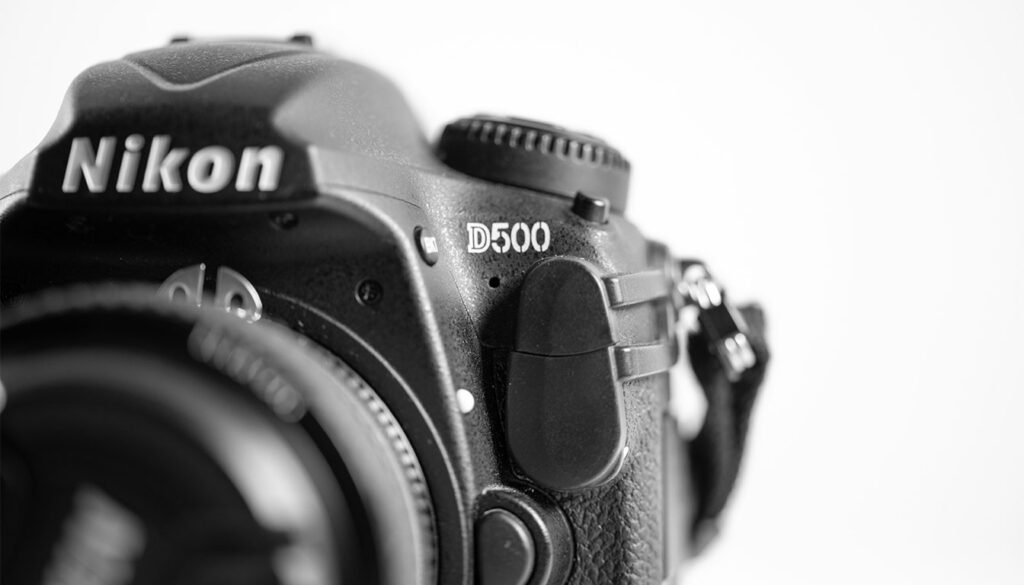
Strengths for Beginners and Hobbyists
For photography newcomers, the D5000 offers an accessible DSLR experience. The articulated screen simplifies composition learning, while straightforward controls avoid overwhelming novices. Lightweight construction makes it ideal for travel photography adventures.
- Affordable entry point: Second-hand prices under £200 provide DSLR quality without breaking the bank
- Forgiving learning curve: Scene modes help beginners understand exposure principles
- Creative flexibility: Flip screen enables unique angles difficult with fixed displays
Drawbacks for Professionals
Commercial photographers face tangible limitations when relying on this ageing system. The single card slot creates backup risks during paid assignments, while 12MP resolution restricts large-format printing. Tethered shooting requires third-party software, complicating studio workflow.
| Professional Use Case | Challenge | Workaround |
|---|---|---|
| Wedding photography | No dual-card redundancy | Shoot duplicate JPEG+RAW to separate cards |
| Product photography | Limited tethering support | Use DigiCamControl software with USB connection |
| Commercial print work | 12MP resolution ceiling | Reserve for small-format publications only |
“The dynamic range falls short for high-end retouching – we’re talking 2-3 stops less than current sensors.”
Colour grading proves particularly challenging, with less headroom in shadows and highlights compared to modern sensors. Client perceptions may also suffer when using visibly outdated gear, despite capable results.
Comparing the D5000 to Modern Alternatives
Stacking the D5000 against contemporary models reveals intriguing trade-offs. While newer options boast advanced features, this veteran DSLR retains niche appeal through simplicity and lens compatibility. Budget-conscious photographers should weigh these factors carefully.
Nikon D5100 vs. D5000
The 2011 D5100 outperforms its predecessor with meaningful upgrades. A 16.2MP sensor captures finer details, while the articulated screen gains 180° rotation for self-portraits. Both share the same EXPEED processor, but the D5100’s dynamic range shows noticeable improvement.
| Feature | D5000 | D5100 |
|---|---|---|
| Sensor Resolution | 12.3MP | 16.2MP |
| ISO Range | 200-3200 | 100-6400 |
| Video Output | 720p | 1080p |
Autofocus remains identical, though the D5100 adds HDR mode for high-contrast scenes. Second-hand prices often differ by just £30-50, making the newer model a sensible upgrade.
Mirrorless Competitors
Models like the Sony a6000 redefine expectations for compact cameras. Its 24MP APS-C sensor and 179-point hybrid autofocus leave the D5000 trailing. The electronic viewfinder provides real-time exposure previews—a game-changer for learners.
- Adapter flexibility: Nikon F-mount lenses work via adapters, though autofocus slows considerably
- Battery trade-offs: Mirrorless models drain power 40% faster during continuous use
- 4K gap: Entry-level mirrorless now offer UHD video, while the D5000 maxes at 720p
“The a6000’s 11fps burst speed makes it ideal for action shots where the D5000 struggles.”
Size advantages prove compelling. The a6000 weighs 344g—nearly 40% lighter than Nikon’s DSLR. For travellers prioritising space, mirrorless cameras deliver comparable quality in smaller packages.
Who Should Buy the Nikon D5000 in 2025?
Certain photographers will find the D5000’s value proposition compelling even today. Its blend of affordability and core functionality creates niche appeal, though specific user groups benefit more than others. Understanding these distinctions prevents mismatched expectations.
Ideal Users: Beginners and Budget Shooters
First-time DSLR owners gain most from this model’s straightforward design. The articulated screen assists composition learning, while physical dials teach exposure fundamentals better than touchscreen interfaces. Lightweight construction makes it ideal for travel photography students.
- Low financial risk: Second-hand prices under £200
- Creative flexibility: Flip screen enables unique angles
- System compatibility: Works with affordable AF-S lenses
| User Type | Benefit | Compromise |
|---|---|---|
| Students | Hands-on learning tool | No Wi-Fi for instant sharing |
| Travellers | Compact DSLR form | Limited weather resistance |
| Family photographers | Reliable JPEG output | Basic video capabilities |
When to Consider Upgrading
Growing photographic ambitions eventually reveal the D5000’s limitations. Professional requirements demand more advanced tools, particularly for these scenarios:
Wedding photography business growth necessitates dual card slots and higher resolution. The single SDHC slot risks catastrophic image loss during paid assignments.
Commercial product photography suffers from tethering challenges and 12MP resolution constraints. Modern 24MP+ sensors provide necessary detail for product catalogues.
“Vloggers outgrow the D5000 quickly—the 720p video and absent microphone input hinder professional content creation.”
Other upgrade triggers include:
- Sports photography requiring faster autofocus
- Gallery exhibitions needing large-format prints
- Low-light work surpassing ISO 1600 capabilities
For those needing modern video features or wireless connectivity, newer mirrorless alternatives prove wiser investments. Yet as an accessible learning tool, the D5000 still delivers remarkable value.
Where to Buy and What to Check
Several UK retailers specialise in refurbished DSLRs with warranties. MPB and Wex Photo Video offer graded used equipment with return policies. London Camera Exchange provides physical inspection opportunities at their high street branches.
Trusted Sellers for Used Models
Established vendors minimise risks with professional servicing. MPB’s 6-month warranty covers electronic faults, while Wex tests all functions pre-sale. Private sellers on eBay may offer lower prices but lack quality guarantees.
“Always request shutter actuation counts—professional refurbishers include this in listings.”
Key Checks Before Purchase
Inspect these critical components when evaluating a second-hand D5000:
- Shutter mechanism: Under 50,000 actuations ensures longevity
- LCD hinge: Test smooth rotation without wobbling
- Sensor condition: Shoot a blank wall at f/22 to spot dust or scratches
Button responsiveness reveals internal wear. Cycle through modes while pressing all controls. The hot shoe should securely mount flashes without looseness.
| Check | Pass Criteria | Tool Needed |
|---|---|---|
| Dead pixels | No bright spots at ISO 1600 | Blank paper |
| Mirror alignment | Even frame coverage | Ruler |
| Firmware | Version 1.01 or later | Menu navigation |
Meeting these standards ensures your investment performs reliably. Always verify the kit lens’ autofocus motor functions if included.
Essential Accessories
Strategic gear selection transforms this DSLR’s capabilities. While the body delivers core functionality, thoughtful add-ons address specific limitations. From lens choices to protective covers, each piece serves a distinct purpose.
Optimising Glass and Technical Add-ons
Beyond the kit lens, several options enhance creative control. A circular polarising filter deepens blue skies and reduces reflections—ideal for landscape work. The Hähnel Captur remote enables vibration-free long exposures without touching the camera.
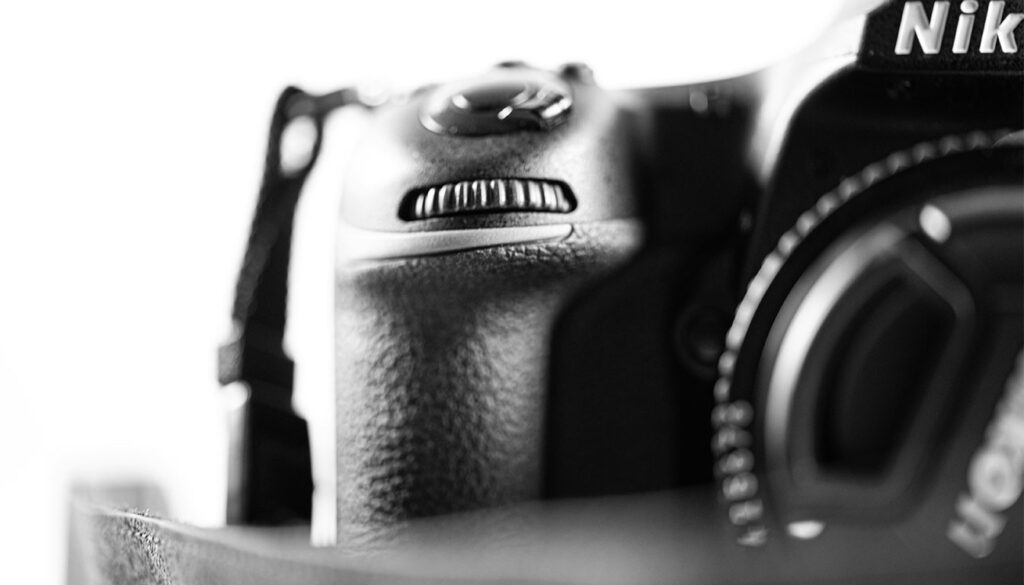
For travel photographers, the Nikon GP-1 GPS module geotags shots automatically. Though discontinued, used units frequently appear on eBay. LED video light kits compensate for the modest built-in flash, offering adjustable colour temperatures.
Practical Enhancements for Daily Use
Maintenance tools prove equally vital. Sensor cleaning swab kits preserve image quality between professional services. Weatherproof covers shield the body during light rain, though heavy downpours still demand shelter.
- Power management: Carry 2-3 EN-EL9a batteries for all-day shoots
- Storage solutions: Pelican cases protect during transport
- Stabilisation: Compact tripods enable sharp low-light shots
These additions modernise the shooting experience without breaking the bank. While newer cameras integrate such features internally, the D5000’s adaptability through gear keeps it relevant.
Conclusion
This DSLR holds value for hobbyists embracing creative constraints. While newer models outperform in speed and resolution, its core functionality remains intact for casual photography.
Choosing second-hand gear benefits both wallets and the environment. The flip screen and lightweight design still inspire unique compositions, proving limitations can spark innovation.
For those sharing work online, the 12MP sensor delivers crisp social media content. Consider upgrading only when commercial needs arise or technical boundaries hinder your vision.
We’d love to see your shots—tag #D5000Vintage on Instagram to showcase what this veteran can achieve. Happy shooting!
FAQ
How does the Nikon D5000 perform in low light?
The D5000 handles dim conditions decently, with an ISO range up to 3200 (expandable to 6400). Noise becomes noticeable at higher settings, but results remain usable for casual photography.
Can the D5000 record high-quality video?
It shoots 720p HD video, which is dated by modern standards. Autofocus struggles during recording, and built-in microphones capture limited sound quality.
Does the D5000 support Wi-Fi or Bluetooth?
No, it lacks wireless connectivity. Users must rely on memory cards or external adapters for file transfers.
What lenses work best with the D5000?
Nikon’s AF-S DX lenses are ideal due to built-in autofocus motors. Older AF lenses won’t autofocus without manual adjustments.
Is the articulating screen useful for photography?
Yes! The tiltable LCD helps with awkward angles and creative compositions, though visibility suffers in bright sunlight.
How long does the battery last per charge?
The EN-EL9a battery delivers around 500 shots per charge, making it reliable for day trips but less suited for extended use.
Is the D5000 suitable for professional work?
While capable, its 12.3MP sensor and limited features make it better suited for hobbyists or beginners rather than professionals.
What’s the burst shooting speed of the D5000?
It captures up to 4 frames per second, which is modest compared to newer models. The buffer fills quickly with RAW files.
Are there modern alternatives to the D5000?
Yes. The Nikon D5100 offers slight upgrades, while mirrorless options like the Z50 provide better autofocus and 4K video.
Where should I buy a used D5000?
Trusted retailers like MPB or Wex Photo Video offer warranties. Always check shutter count, sensor condition, and button functionality before purchasing.
